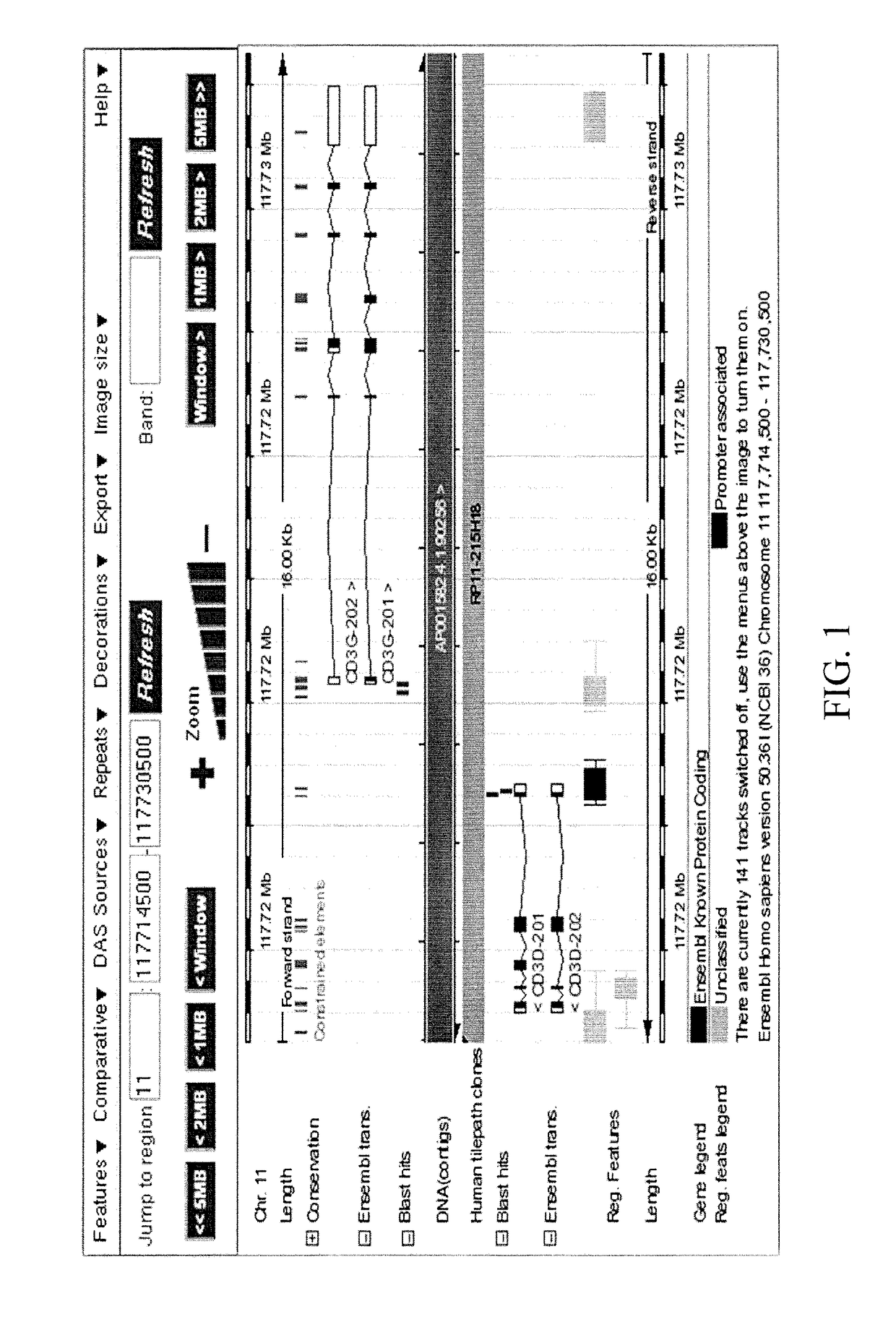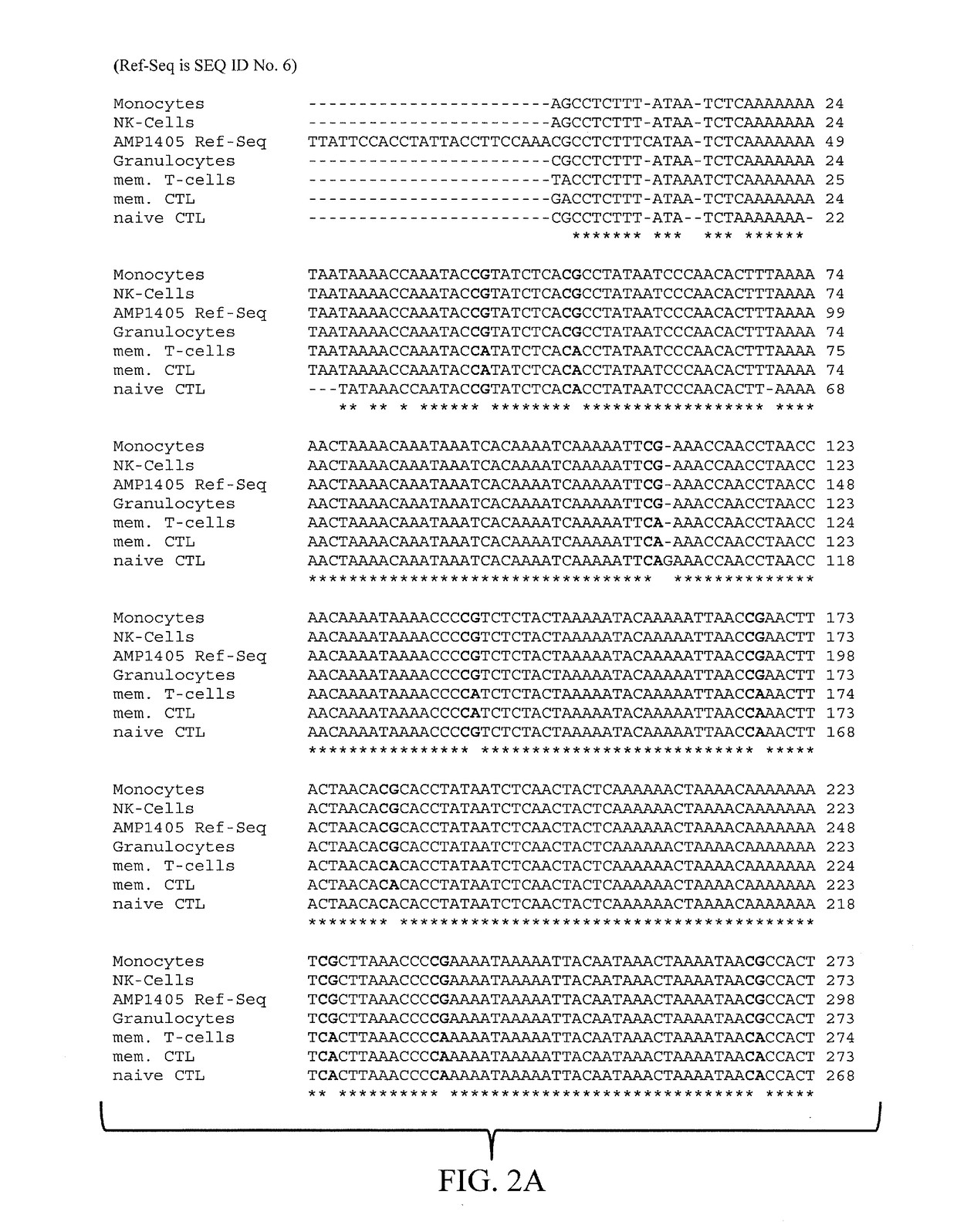Epigenetic Markers for the Identification of Blood Sub-cells of Type 1
a type 1 and epigenetic marker technology, applied in the field of epigenetic markers for the identification of blood sub-cells of type 1, can solve the problems of difficult to determine these cell types, paper does not identify the regions as analyzed, and the detection of t lymphocytes, while desirable, is problematic, etc., to achieve precise analysis and more robust
- Summary
- Abstract
- Description
- Claims
- Application Information
AI Technical Summary
Benefits of technology
Problems solved by technology
Method used
Image
Examples
example 1
sis
[0079]The inventors have purified various blood subsets, including CD3 / CD4, CD3 / CD8 naïve and memory T lymphocytes, CD56 natural killer cells, CD19 naïve and memory B cells, CD14 monocytes and CD15 granulocytes. DNA from the purified cells was bisulfite-treated and analysed at various CpG dinucleotide motifs. The inventors then compared the methylation status (finding C as for Cytosine that was methylated in the original sequence versus T for cytosine that was unmethylated in the original sequence).
[0080]The data showed various CpG motifs and areas in the CD3 γ, δ and ε that were demethylated in all CD3CD4 and CD3CD8 cell types while methylated in all other blood cell types. The differentially methylated gene regions as found for CD3 γ, δ and ε are shown below in FIG. 1 and are indicated in bold as “blast hits.”
[0081]The data, as observed with Illumina Golden Gate technology, show that all CD4 and CD8 positive memory (0.06 and 0.06 respectively) and naïve (0.03 and 0.06, respecti...
example 2
of Additional Markers in Analogy to CD3
[0085]In order to identify further suitable markers distinguishing and monitoring T-lymphocytes, other markers in addition to CD3 have been identified and tested through methylation analysis. It was found that methylation in the CpG positions in the genes for SLA2, CHRNA3, C16orf24, LCK, FASLG, CD7, SIT1, IL32, CXCR6, UBASH3A, GRAP2, ITGB7 and TXK can also be used in the context of the present invention, as these markers are also able to identify CD3 positive T lymphocytes.
[0086]Furthermore, other markers have been identified that identify the subset of the CD8 and CD4 positive cells in the group of CD3 positive T lymphocytes. The genes for GNGT2, CRTAM, IL2RB and ZBTB32 have been found to segregate between CD8 and CD4 positive cells. Equivalently, FLJ00060, FLJ38379, PPP6C, CD226, ZBTB7B and TNFAIP8 are capable of positively identifying CD4 expressing cells in whole blood and segregate between CD4 and CD8 positive CD3 positive cells.
[0087]The ...
PUM
| Property | Measurement | Unit |
|---|---|---|
| Fraction | aaaaa | aaaaa |
| Fraction | aaaaa | aaaaa |
| Mass | aaaaa | aaaaa |
Abstract
Description
Claims
Application Information
 Login to View More
Login to View More - R&D Engineer
- R&D Manager
- IP Professional
- Industry Leading Data Capabilities
- Powerful AI technology
- Patent DNA Extraction
Browse by: Latest US Patents, China's latest patents, Technical Efficacy Thesaurus, Application Domain, Technology Topic, Popular Technical Reports.
© 2024 PatSnap. All rights reserved.Legal|Privacy policy|Modern Slavery Act Transparency Statement|Sitemap|About US| Contact US: help@patsnap.com










